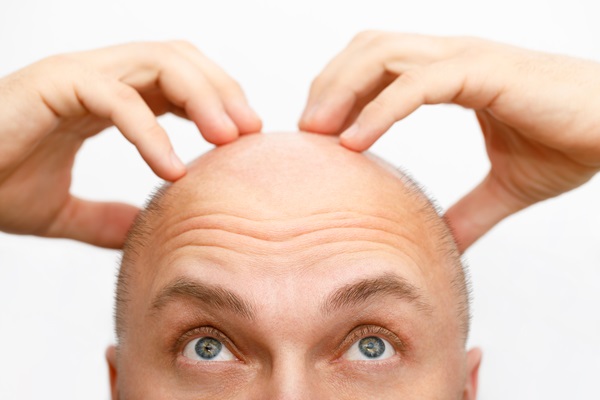Receding Hairline TreatmentSchaumburg, IL
Whether hair loss is due to natural causes or a medical condition, a receding hairline can hurt your confidence and appearance. Fortunately, various treatments are available to slow down or even prevent a receding hairline. Since many issues can be responsible for this condition, it is important to have an examination to determine the best treatment option for you.
With professional evaluation and proper treatment, you can fight hair loss and reach your hair goals. Receding hairline treatment is available at Dillon Hair Restoration in Schaumburg and the surrounding area. Call us at 847-241-2132 to learn more about our services or schedule an appointment.
Understanding Receding Hairlines
A receding hairline can cause hair loss in a variety of different patterns. This type of hair loss typically begins when the hairline creeps back on either side of the scalp, exposing more of the forehead. After this, a bald spot often occurs on the crown along with thinning on the top of the head.
Receding hairlines are more common in men than women. Many men experience a receding hairline by the time they reach their late 30s. The average person has around 100,000 hairs and normally sheds between 50 and 100 hairs each day. Losing more than this amount can be a sign of damaged hair follicles or a disturbed growth cycle, resulting in a receding hairline.
Causes of Receding Hairlines
A receding hairline can result from hair follicle damage or a medical condition that disturbs the growth cycle. People who have a family history of this condition are more likely to lose their hair. Men are especially affected by this hereditary trait as male hormones can result in overly sensitive hair follicles. Changes in hormones, such as those in menopause, can cause women to be affected by receding hairlines as well.
Other common causes of receding hairlines include:
- Autoimmune disorders
- Poor diet high in saturated fat, processed foods, preservatives, and sugar
- Hairstyles that pull the hair back tightly
- Medical conditions such as infectious diseases or ovarian tumors
- Medical procedures or treatments
- Smoking cigarettes
- Stress
Stages of a Receding Hairline
Hair loss patterns in men and women are different. In men, the progression of a receding hairline usually occurs in steps. At first, the hairline appears uneven before a noticeable “M” shape appears. Then, hair loss at the top or back of the head results in a bald spot. Eventually, the area with the receding hairline meets the bald spot, creating a larger bald area and even complete balding.
. Women do not typically experience the same stages of hair loss as men. Women experience thinning hair or gradual hair loss. One of the first signs of a receding hairline in women is a smaller ponytail. Receding hairlines in women will usually spare the sides and back of the head, while the part over the top of the scalp will widen and thin considerably.
Diagnosing a Receding Hairline
Our doctor can help patients understand the type of hair loss that they are experiencing. To make the proper diagnosis, they will ask about the patient’s family and personal medical history. Patients may receive a “pull test” where our doctor will pull gently on a few hairs to see how many hairs fall out and how easily.
A scalp tissue or hair biopsy can help determine if a patient’s hair loss is due to a scalp infection. Our doctor will take a small piece of affected tissue during a biopsy and send it to the lab for testing. Patients may also have a blood test to look for conditions that can contribute to hair loss like thyroid disease.
Treatments for Receding Hairlines
Treatment of receding hairlines depends on the underlying cause. Patients that experience this hair loss as a result of an age-related development do not require medical treatment. However, if a medical condition causes hair loss, medication may be necessary.
Various treatments and procedures are available to combat hair loss that causes receding hairlines. There are over-the-counter and prescription medications that can help slow or reverse hair loss. Surgical procedures like hair restoration surgery are also available to help stop a receding hairline. This procedure consists of transplanting small sections of scalp or hair follicles to sparse or no hair growth areas.
Call Us Today
Receding hairlines can happen to anyone and at any age. Luckily, this condition is more treatable than ever. Our team at Dillon Hair Restoration can help. Call us today at 847-241-2132 to schedule an appointment or learn more about our services.
Frequently Asked Questions
What are the types of hair restoration surgeries?
There are four primary types of hair replacement surgeries. They include hair transplantation, tissue expansion, flap surgery, and scalp reduction. The two most common hair transplants are follicular unit transplantation (FUT) and follicular unit extraction (FUE).
How common are receding hairlines?
Receding hairlines are common conditions. Though they can occur in either gender, they are much more common in men than in women. According to the Journal of Investigative Dermatology, up to 80% of European men experience receding hairlines by the time they are 80 years of age.
Does a receding hairline always result in baldness?
Having a receding hairline does not always result in baldness. However, it can be an early sign of male pattern baldness. In other cases, this condition can change the hairline without progressing any further.
What hormones can cause a receding hairline?
Hormones are the most common cause of hair loss in men and women. Dihydrotestosterone (DHT) is a hormone in both sexes that is often responsible for hair loss. The body produces DHT as a byproduct of testosterone, which can inhibit hair growth as it causes the follicles to shrink so that no hair can grow in them anymore.
How can I prevent a receding hairline?
Although it is not possible to completely prevent a receding hairline, there are measures that people can take to slow hair loss. Living a healthy lifestyle with exercise and a diet rich in vitamins and nutrients can help people make the most of their hair. It is also important to keep stress levels in check, as it can cause hormone levels to rise, which affects the growth pattern of follicles on scalps.
Contact Us
Dillon Hair Restoration is located at 890 E Higgins Rd Ste 158 Schaumburg, IL 60173.





